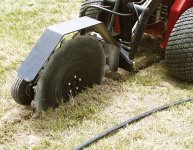Redgoatea
Gold Member
handirifle said:As for ease of construction, and cost, you're most likely correct. I just can't shake this idea.
This, certainly is not a heavy duty idea, it's a light duty, concept, meant for trenching narrow trenches for sprinkler lines. This is geared to compete with someone using a trenching shovel, rather than a 900 lb. Ditch Witch.
I totally understand once a concept takes hold ya get excited and the desire to see it through can keep ya up at night. I totally applaud your ingenuity and I say if you have an idea go for it. Who knows it may even work better than you think it will and that could lead to places. As the saying goes "necessity is the mother of invention"
Sometimes the necessity is just to try your own ideas. Good luck.

